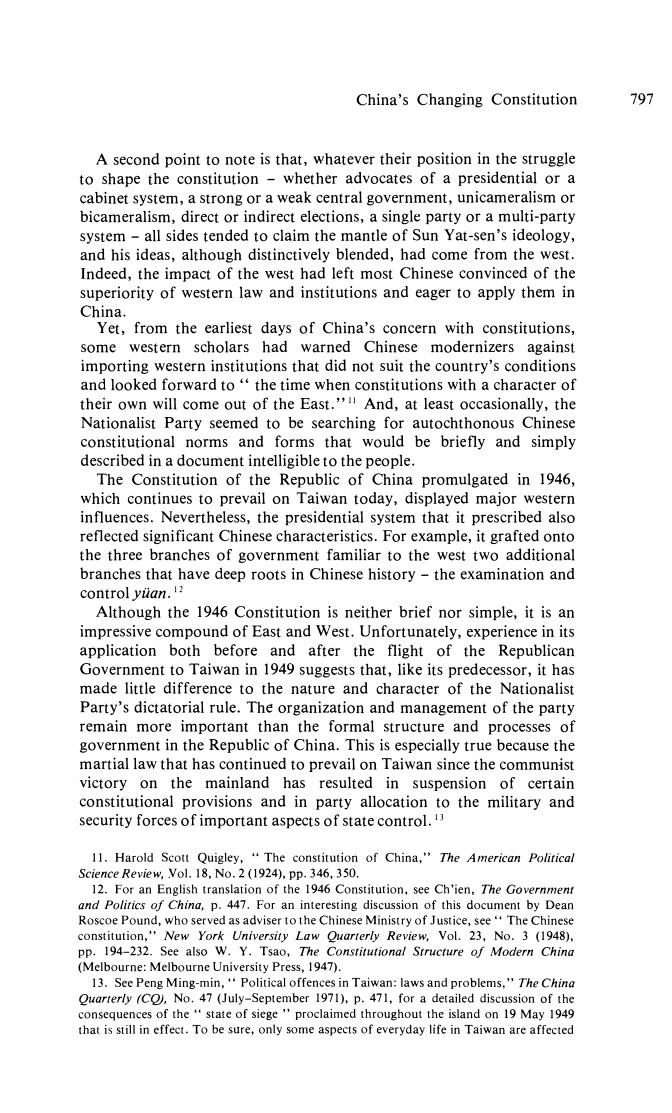正在加载图片...

China's Changing Constitution 797 A second point to note is that,whatever their position in the struggle to shape the constitution-whether advocates of a presidential or a cabinet system,a strong or a weak central government,unicameralism or bicameralism,direct or indirect elections,a single party or a multi-party system -all sides tended to claim the mantle of Sun Yat-sen's ideology, and his ideas,although distinctively blended,had come from the west. Indeed,the impact of the west had left most Chinese convinced of the superiority of western law and institutions and eager to apply them in China. Yet,from the earliest days of China's concern with constitutions, some western scholars had warned Chinese modernizers against importing western institutions that did not suit the country's conditions and looked forward to"the time when constitutions with a character of their own will come out of the East."And,at least occasionally,the Nationalist Party seemed to be searching for autochthonous Chinese constitutional norms and forms that would be briefly and simply described in a document intelligible to the people. The Constitution of the Republic of China promulgated in 1946, which continues to prevail on Taiwan today,displayed major western influences.Nevertheless,the presidential system that it prescribed also reflected significant Chinese characteristics.For example,it grafted onto the three branches of government familiar to the west two additional branches that have deep roots in Chinese history-the examination and control yuan.? Although the 1946 Constitution is neither brief nor simple,it is an impressive compound of East and West.Unfortunately,experience in its application both before and after the flight of the Republican Government to Taiwan in 1949 suggests that,like its predecessor,it has made little difference to the nature and character of the Nationalist Party's dictatorial rule.The organization and management of the party remain more important than the formal structure and processes of government in the Republic of China.This is especially true because the martial law that has continued to prevail on Taiwan since the communist victory on the mainland has resulted in suspension of certain constitutional provisions and in party allocation to the military and security forces of important aspects of state control. 11.Harold Scott Quigley,"The constitution of China,"The American Political Science Review,Vol.18,No.2(1924),pp.346,350. 12.For an English translation of the 1946 Constitution,see Ch'ien,The Government and Politics of China,p.447.For an interesting discussion of this document by Dean Roscoe Pound,who served as adviser to the Chinese Ministry of Justice,see"The Chinese constitution,"New York University Law Quarterly Review,Vol.23,No.3 (1948), pp.194-232.See also W.Y.Tsao,The Constitutional Structure of Modern China (Melbourne:Melbourne University Press,1947). 13.See Peng Ming-min,Political offences in Taiwan:laws and problems,"The China Quarterly (CO,No.47 (July-September 1971),p.471,for a detailed discussion of the consequences of the"state of siege"proclaimed throughout the island on 19 May 1949 that is still in effect.To be sure,only some aspects of everyday life in Taiwan are affectedChina's Changing Constitution 797 A second point to note is that, whatever their position in the struggle to shape the constitution - whether advocates of a presidential or a cabinet system, a strong or a weak central government, unicameralism or bicameralism, direct or indirect elections, a single party or a multi-party system - all sides tended to claim the mantle of Sun Yat-sen's ideology, and his ideas, although distinctively blended, had come from the west. Indeed, the impact of the west had left most Chinese convinced of the superiority of western law and institutions and eager to apply them in China. Yet, from the earliest days of China's concern with constitutions, some western scholars had warned Chinese modernizers against importing western institutions that did not suit the country's conditions and looked forward to " the time when constitutions with a character of their own will come out of the East." " And, at least occasionally, the Nationalist Party seemed to be searching for autochthonous Chinese constitutional norms and forms that would be briefly and simply described in a document intelligible to the people. The Constitution of the Republic of China promulgated in 1946, which continues to prevail on Taiwan today, displayed major western inRuences. Nevertheless, the presidential system that it prescribed also reflected significant Chinese characteristics. For example, it grafted onto the three branches of government familiar to the west two additional branches that have deep roots in Chinese history - the examination and control yuan. 1 2 Although the 1946 Constitution is neither brief nor simple, it is an impressive compound of East and West. Unfortunately, experience in its application both before and after the flight of the Republican Governmento Taiwan in 1949 suggests that, like its predecessor, it has made little difference to the nature and character of the Nationalist Party's dictatorial rule. The organization and management of the party remain more important than the formal structure and processes of government in the Republic of China. This is especially true because the martial law that has continued to prevail on Taiwan since the communost victory on the mainland has resulted in suspension of certain constitutional provisions and in party allocation to the military and security forces of important aspects of state control. 13 11. Harold Scott Quigley, " The constitution of China," The American Political ScienceReview, .Vol. 18, No. 2 (1924), pp. 346, 350. 12. For an English translation of the 1946 Constitution, see Ch'ien, The Government and Politics of China, p. 447. For an interesting discussion of this document by Dean Roscoe Pound, who served as adviser to the Chinese Ministry of Justice, see " The Chinese constitution, " New York University Law Quarterly Review, Vol. 23, No . 3 ( 1948), pp. 194-232. See also W. Y. Tsao, The Constitutional Structure of Modern China (Melbourne: Melbourne University Press, 1947). 13. See Peng Ming-min, " Political offences in Taiwan: laws and problems," The China Quarterly (CQ), No. 47 (July-September 1971), p. 471, for a detailed discussion of the consequences of the " state of siege " proclaimed throughout the island on 19 May 1949 that is still in effect. To be sure, only some aspects of everyday life in Taiwan are affected